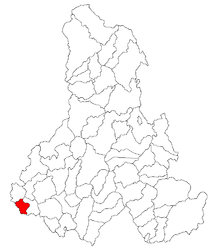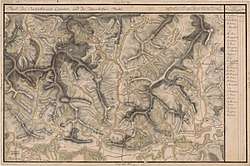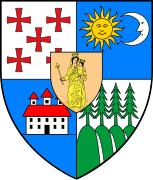Secuieni, Harghita
Secuieni (Hungarian: Újszékely, Hungarian pronunciation: [ˈuːjseːkɛj]) is a commune in Harghita County, Romania. It lies in the Székely Land, an ethno-cultural region in eastern Transylvania.
Secuieni Újszékely | |
|---|---|
 Reformed Church in Secuieni | |
 Location in Harghita County | |
 Secuieni Location in Romania | |
| Coordinates: 46°15′0″N 24°58′6″E | |
| Country | |
| County | Harghita |
| Government | |
| • Mayor | Mózes Furi (UDMR) |
| Area | 40.42 km2 (15.61 sq mi) |
| Population (2011)[1] | 2,644 |
| • Density | 65/km2 (170/sq mi) |
| Time zone | EET/EEST (UTC+2/+3) |
| Postal code | 537290 |
| Area code | +40 266 |
| Vehicle reg. | HR |
Component villages
The commune is composed of three villages:
| In Romanian | In Hungarian |
|---|---|
| Bodogaia | Alsóboldogfalva |
| Eliseni | Székelyszenterzsébet |
| Secuieni | Újszékely |
History

The villages were part of the Székely Land region of the historical Transylvania province. They belonged to Udvarhelyszék district until the administrative reform of Transylvania in 1876, when they fell within the Udvarhely County in the Kingdom of Hungary. After the Treaty of Trianon of 1920, they became part of Romania and fell within Odorhei County during the interwar period. In 1940, the second Vienna Award granted the Northern Transylvania to Hungary and the villages were held by Hungary until 1944. After Soviet occupation, the Romanian administration returned and the commune became officially part of Romania in 1947. Between 1952 and 1960, the commune fell within the Magyar Autonomous Region, between 1960 and 1968 the Mureș-Magyar Autonomous Region.
In 1968, the province was abolished, and since then, the commune has been part of Harghita County.
Demographics
The commune has an absolute Székely Hungarian majority. According to the 2002 census it has a population of 2,660 of which 93.57% or 2,489 are ethnic Hungarian.[2]
References
- "Populaţia stabilă pe judeţe, municipii, oraşe şi localităti componenete la RPL_2011" (in Romanian). National Institute of Statistics. Retrieved 4 February 2014.
- Romanian Census 2002; retrieved on July 16, 2010
